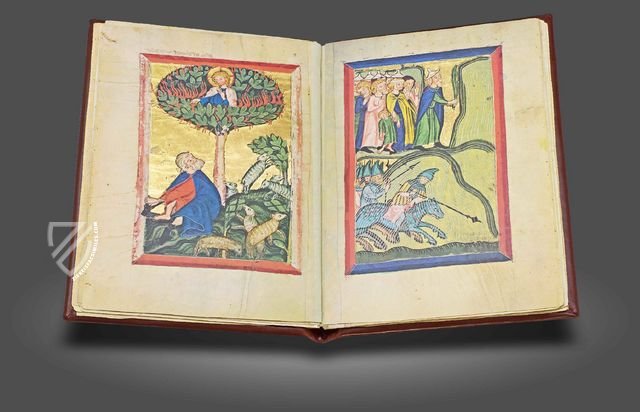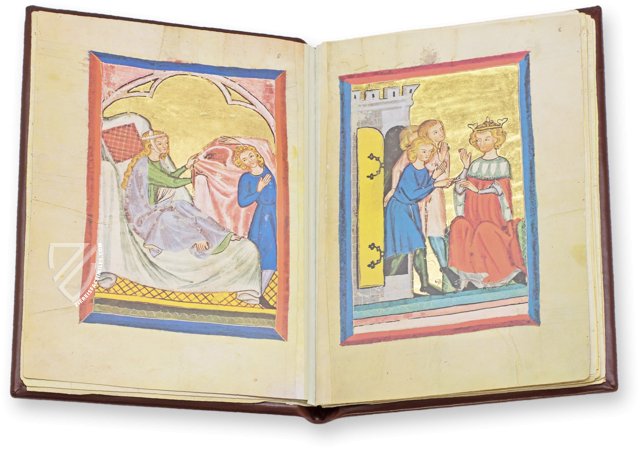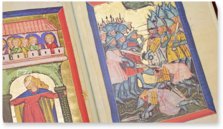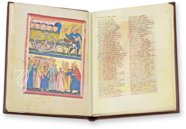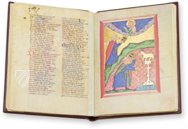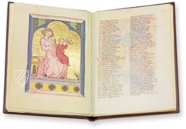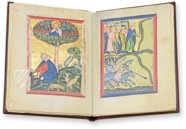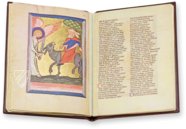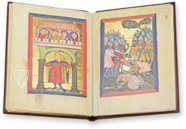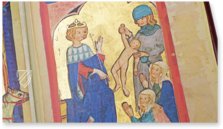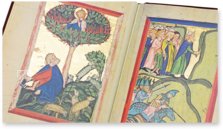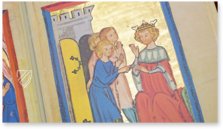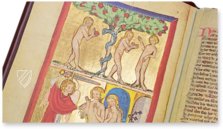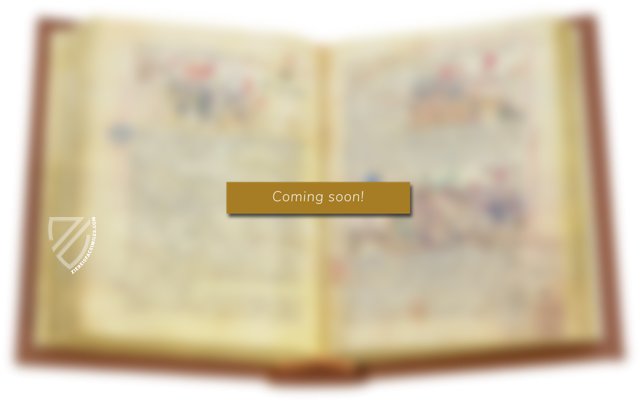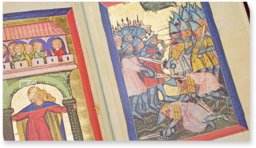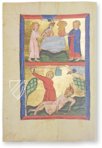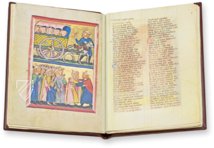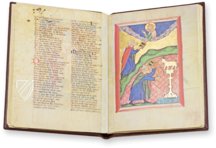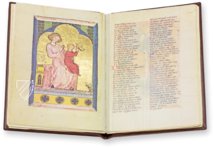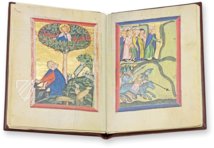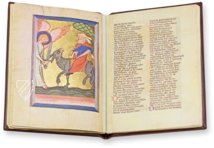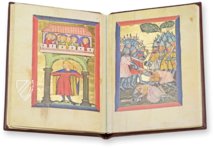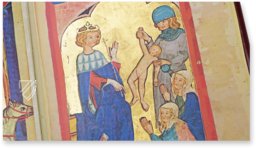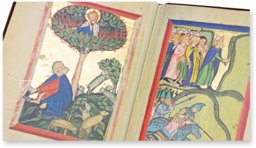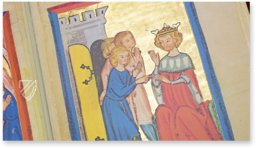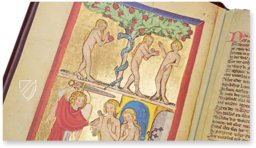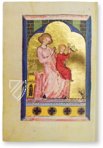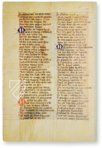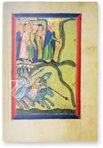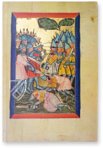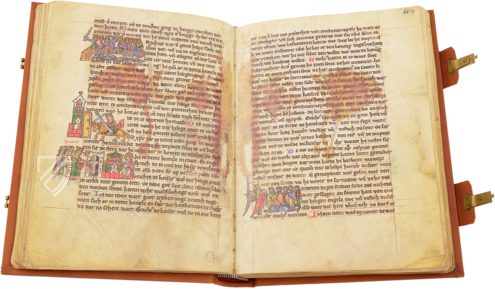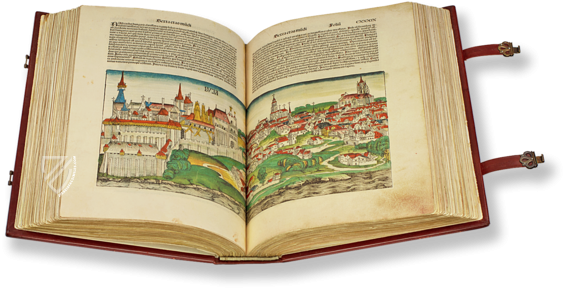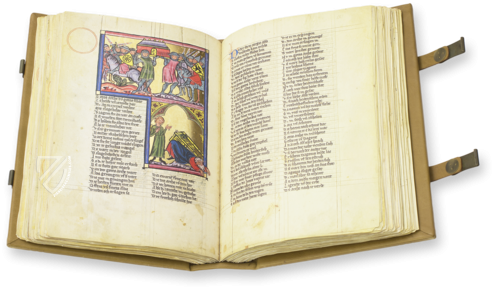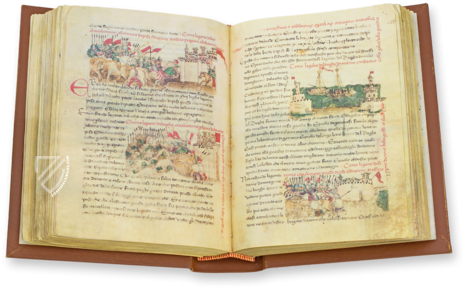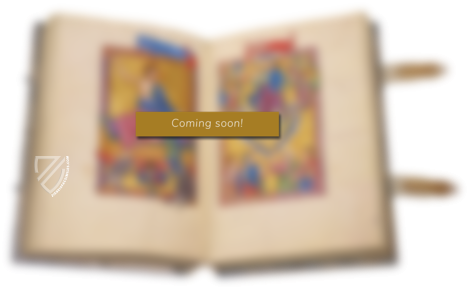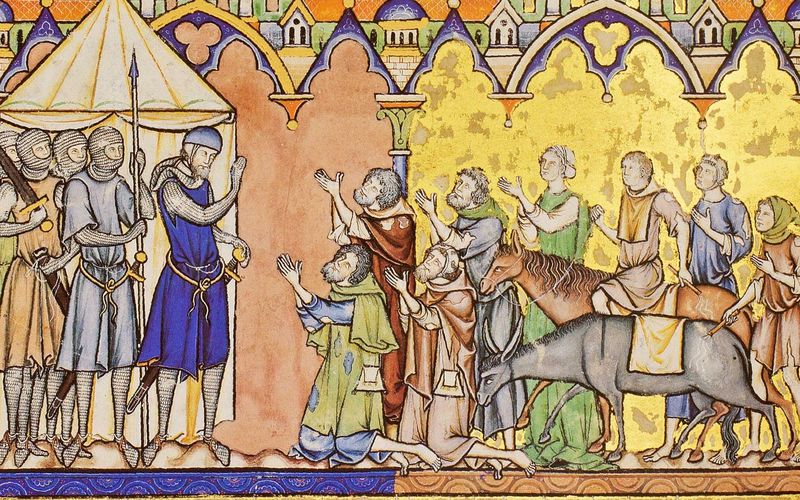Chronicle of the World and History of Charlemagne
(1,000€ - 3,000€)
This manuscript in the Berliner Staatsbibliothek contains part of one of the most popular books of the Middle Ages. Originating from a royal commission, the World Chronicle by the poet Rudolf von Ems is considered to be one of the first historical works written in the German language. The fragmented work was appended in the manuscript by the Stricker’s epic Charlemagne. Both these distinguished works of medieval literature are artfully illustrated.
Chronicle of the World and History of Charlemagne
This manuscript in the Berliner Staatsbibliothek contains part of one of the most popular books of the Middle Ages. Originating from a royal commission, the work by the poet Rudolf von Ems is considered to be one of the first historical works written in the German language. The fragmented work was appended in the manuscript by the Stricker’s epic Charlemagne. Both these distinguished works of medieval literature are artfully illustrated.
Two Significant Literary Works of the Middle Ages
Rudolf von Ems, who came from Vorarlberg, completed his World Chronicle ca. 1255 at the behest of King Conrad IV son of the Hohenstaufen King Frederick II. The literary work relied on various sources and dealt with events from the Bible up to the present, already enjoying great popularity in the author’s lifetime. Recorded in German with skillful verses, it depicts tales in the Old Testament from Genesis to Solomon as historical events and deals with them similarly to ancient history and contemporary events. The literarily significant work survives today in 100+ manuscripts and fragments, which further corroborates its wide circulation and great popularity. The second, considerably smaller part of the Berlin manuscript consists of a fragment by the epic Charlemagne, which the largely unresearched poem named Stricker composed ca. 1220. The 778 campaign against the Saracens makes up the background that the tales plays out in front of. Stricker composed his epic about Charlemagne in the tradition of the 12th century heroic epic, which were also largely dedicated to the figure of Charlemagne.
Entertaining Miniature Pages in Luminous Colors
The 23 pages altogether of the Berlin manuscript mostly assembles illustrations from both texts, with the text on the backside of the respective page. It was probably because of their high artistic quality that the consistently full-page image pages were removed from their original manuscripts and stored separately. The illustrations in the first half can be stylistically dated to the 14th century. The miniatures have been matched with the circle of the Codex Manesse, but the identity of the participating artists remains a mystery to this day. The historical and biblical events, set in the contemporary court life of the 13th century with knights, crowned heads, and noble ladies, are depicted in powerfully luminous colors. An additionally interesting aspect bound up with the Berlin manuscript is the provenance of the book. Both manuscript fragments (probably already bound together) were acquired in 1826 by the famous German poet August Heinrich Hoffmann von Fallersleben. They left his collection in 1850 after being sold to Berlin’s Royal Library.
Codicology
- Alternative Titles
- Die Weltchronik + Karl der Grosse
Cronaca del Mondo e Storia di Carlo Magno
Chronicle of the World and History of Charlemagne
Cronica del Mundo
Berlin World Chronicle - Size / Format
- 46 pages / 28.0 × 19.0 cm
- Origin
- Germany
- Date
- Ca. 1250
- Style
- Language
- Illustrations
- 23 full-page miniatures, vibrantly colored and opaque, with striking use of gold
- Artist / School
- Rudolf von Ems (ca. 1200 – ca. 1254) (author)
"Der Stricker" (author) - Previous Owners
- Jacobus Koning (1770–1832)
August Heinrich Hoffmann von Fallersleben (1798–1874)
Chronicle of the World and History of Charlemagne
Jonathan and the Honeycomb
This gory miniature may be unique and depicts the story of Jonathan. In 1 Samuel, Jonathan the eldest son of King Saul, leads the Israelites to victory over the Philistines, depicted with long beards and Phrygian helmets. Wearing a crown, Jonathan puts a honeycomb to his mouth, unknowingly breaking his father’s command that everyone fast until evening. He argues with his father about the fast and is nearly put to death, but King Saul spares Jonathan due to the protests of the soldiers.
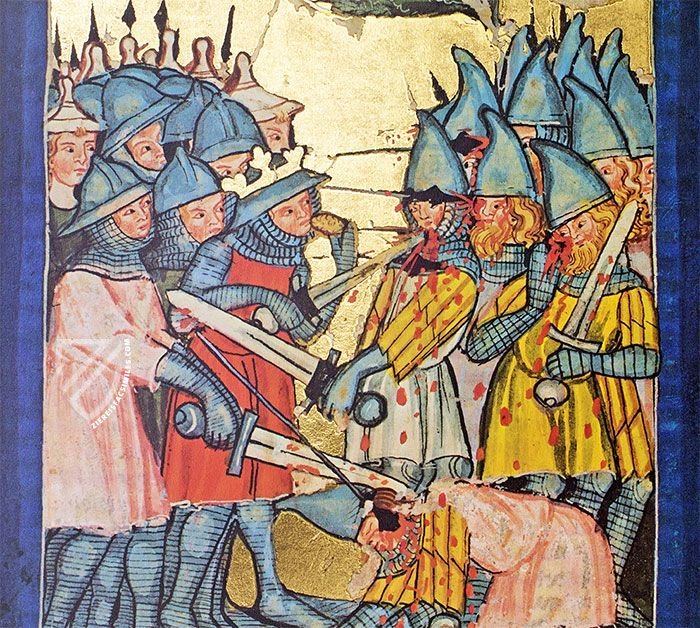
Chronicle of the World and History of Charlemagne
Moses Throws Pharaoh’s Crown
In an apocryphal scene from the life of Moses, the young boy is sitting on the lap of Pharaoh’s daughter, who has adopted him, when the crown is playfully placed on his head. Young Moses promptly removes the crown from his head and casts it to the ground, breaking it. Medieval audiences were particularly fond of such scenes that foreshadowed later events.
Set within an architectural frame featuring Gothic elements, the scene has a splendidly radiant gold background. Pharaoh’s daughter has her hair “up” in a red lace hairnet, which were common in 13th century Germany and England and were made from the finest silk. The crown is first shown in tact in Moses’ hand, then broken on the ground in the lower right corner.
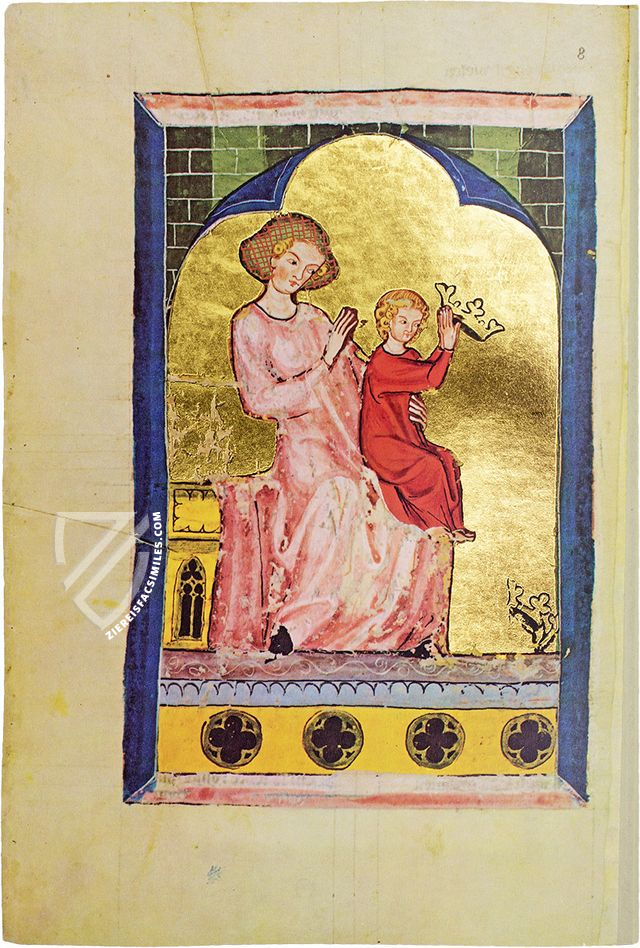
#1 Cronaca del Mondo e Storia di Carlo Magno
Language: Italian
(1,000€ - 3,000€)
#2 Die Weltchronik - Karl der Große
Language: German
(1,000€ - 3,000€)
- Treatises / Secular Books
- Apocalypses / Beatus
- Astronomy / Astrology
- Bestiaries
- Bibles / Gospels
- Chronicles / History / Law
- Geography / Maps
- Saints' Lives
- Islam / Oriental
- Judaism / Hebrew
- Single Leaf Collections
- Leonardo da Vinci
- Literature / Poetry
- Liturgical Manuscripts
- Medicine / Botany / Alchemy
- Music
- Mythology / Prophecies
- Psalters
- Other Religious Books
- Games / Hunting
- Private Devotion Books
- Other Genres
- Afghanistan
- Armenia
- Austria
- Belgium
- Belize
- Bosnia and Herzegovina
- China
- Colombia
- Costa Rica
- Croatia
- Cyprus
- Czech Republic
- Denmark
- Egypt
- El Salvador
- Ethiopia
- France
- Germany
- Greece
- Guatemala
- Honduras
- Hungary
- India
- Iran
- Iraq
- Israel
- Italy
- Japan
- Jordan
- Kazakhstan
- Kyrgyzstan
- Lebanon
- Liechtenstein
- Luxembourg
- Mexico
- Morocco
- Netherlands
- Palestine
- Panama
- Peru
- Poland
- Portugal
- Romania
- Russia
- Serbia
- Spain
- Sri Lanka
- Sweden
- Switzerland
- Syria
- Tajikistan
- Turkey
- Turkmenistan
- Ukraine
- United Kingdom
- United States
- Uzbekistan
- Vatican City
- A. Oosthoek, van Holkema & Warendorf
- Aboca Museum
- Ajuntament de Valencia
- Akademie Verlag
- Akademische Druck- u. Verlagsanstalt (ADEVA)
- Aldo Ausilio Editore - Bottega d’Erasmo
- Alecto Historical Editions
- Alkuin Verlag
- Almqvist & Wiksell
- Amilcare Pizzi
- Andreas & Andreas Verlagsbuchhandlung
- Archa 90
- Archiv Verlag
- Archivi Edizioni
- Arnold Verlag
- ARS
- Ars Magna
- ArtCodex
- AyN Ediciones
- Azimuth Editions
- Badenia Verlag
- Bärenreiter-Verlag
- Belser Verlag
- Belser Verlag / WK Wertkontor
- Benziger Verlag
- Bernardinum Wydawnictwo
- BiblioGemma
- Biblioteca Apostolica Vaticana (Vaticanstadt, Vaticanstadt)
- Bibliotheca Palatina Faksimile Verlag
- Bibliotheca Rara
- Boydell & Brewer
- Bramante Edizioni
- Bredius Genootschap
- Brepols Publishers
- British Library
- C. Weckesser
- Caixa Catalunya
- Canesi
- CAPSA, Ars Scriptoria
- Caratzas Brothers, Publishers
- Carus Verlag
- Casamassima Libri
- Centrum Cartographie Verlag GmbH
- Chavane Verlag
- Christian Brandstätter Verlag
- Circulo Cientifico
- Club Bibliófilo Versol
- Club du Livre
- CM Editores
- Collegium Graphicum
- Collezione Apocrifa Da Vinci
- Comissão Nacional para as Comemorações dos Descobrimentos Portugueses
- Coron Verlag
- Corvina
- CTHS
- D. S. Brewer
- Damon
- De Agostini/UTET
- De Nederlandsche Boekhandel
- De Schutter
- Deuschle & Stemmle
- Deutscher Verlag für Kunstwissenschaft
- DIAMM
- Droz
- E. Schreiber Graphische Kunstanstalten
- Ediciones Boreal
- Ediciones Grial
- Ediclube
- Edições Inapa
- Edilan
- Editalia
- Edition Deuschle
- Edition Georg Popp
- Edition Leipzig
- Edition Libri Illustri
- Editiones Reales Sitios S. L.
- Éditions de l'Oiseau Lyre
- Editions Medicina Rara
- Editorial Casariego
- Editorial Mintzoa
- Editrice Antenore
- Editrice Velar
- Edizioni Edison
- Egeria, S.L.
- Eikon Editores
- Electa
- Emery Walker Limited
- Enciclopèdia Catalana
- Eos-Verlag
- Ephesus Publishing
- Ernst Battenberg
- Eugrammia Press
- Extraordinary Editions
- Fackelverlag
- Facsimila Art & Edition
- Facsimile Editions Ltd.
- Facsimilia Art & Edition Ebert KG
- Faksimile Verlag
- Feuermann Verlag
- Folger Shakespeare Library
- Franco Cosimo Panini Editore
- Friedrich Wittig Verlag
- Fundación Hullera Vasco-Leonesa
- G. Braziller
- Gabriele Mazzotta Editore
- Gebr. Mann Verlag
- Gesellschaft für graphische Industrie
- Getty Research Institute
- Giovanni Domenico de Rossi
- Giunti Editore
- Graffiti
- Grafica European Center of Fine Arts
- Guido Pressler
- Guillermo Blazquez
- Gustav Kiepenheuer
- H. N. Abrams
- Harrassowitz
- Harvard University Press
- Helikon
- Hendrickson Publishers
- Henning Oppermann
- Herder Verlag
- Hes & De Graaf Publishers
- Hoepli
- Holbein-Verlag
- Houghton Library
- Hugo Schmidt Verlag
- Idion Verlag
- Il Bulino, edizioni d'arte
- ILte
- Imago
- Insel Verlag
- Insel-Verlag Anton Kippenberger
- Instituto de Estudios Altoaragoneses
- Instituto Nacional de Antropología e Historia
- Istituto dell'Enciclopedia Italiana - Treccani
- Istituto Ellenico di Studi Bizantini e Postbizantini
- Istituto Geografico De Agostini
- Istituto Poligrafico e Zecca dello Stato
- Italarte Art Establishments
- Jan Thorbecke Verlag
- Johnson Reprint Corporation
- Josef Stocker
- Josef Stocker-Schmid
- Jugoslavija
- Karl W. Hiersemann
- Kasper Straube
- Kaydeda Ediciones
- Kindler Verlag / Coron Verlag
- Kodansha International Ltd.
- Konrad Kölbl Verlag
- Kurt Wolff Verlag
- La Liberia dello Stato
- La Linea Editrice
- La Meta Editore
- Lambert Schneider
- Landeskreditbank Baden-Württemberg
- Leo S. Olschki
- Les Incunables
- Liber Artis
- Library of Congress
- Libreria Musicale Italiana
- Lichtdruck
- Lito Immagine Editore
- Lumen Artis
- Lund Humphries
- M. Moleiro Editor
- Maison des Sciences de l'homme et de la société de Poitiers
- Manuscriptum
- Martinus Nijhoff
- Maruzen-Yushodo Co. Ltd.
- MASA
- Massada Publishers
- McGraw-Hill
- Metropolitan Museum of Art
- Militos
- Millennium Liber
- Müller & Schindler
- Nahar - Stavit
- Nahar and Steimatzky
- National Library of Wales
- Neri Pozza
- Nova Charta
- Oceanum Verlag
- Odeon
- Orbis Mediaevalis
- Orbis Pictus
- Österreichische Staatsdruckerei
- Oxford University Press
- Pageant Books
- Parzellers Buchverlag
- Patrimonio Ediciones
- Pattloch Verlag
- PIAF
- Pieper Verlag
- Plon-Nourrit et cie
- Poligrafiche Bolis
- Presses Universitaires de Strasbourg
- Prestel Verlag
- Princeton University Press
- Prisma Verlag
- Priuli & Verlucca, editori
- Pro Sport Verlag
- Propyläen Verlag
- Pytheas Books
- Quaternio Verlag Luzern
- Reales Sitios
- Recht-Verlag
- Reichert Verlag
- Reichsdruckerei
- Reprint Verlag
- Riehn & Reusch
- Roberto Vattori Editore
- Rosenkilde and Bagger
- Roxburghe Club
- Salerno Editrice
- Saltellus Press
- Sandoz
- Sarajevo Svjetlost
- Schöck ArtPrint Kft.
- Schulsinger Brothers
- Scolar Press
- Scrinium
- Scripta Maneant
- Scriptorium
- Shazar
- Siloé, arte y bibliofilia
- SISMEL - Edizioni del Galluzzo
- Sociedad Mexicana de Antropología
- Société des Bibliophiles & Iconophiles de Belgique
- Soncin Publishing
- Sorli Ediciones
- Stainer and Bell
- Studer
- Styria Verlag
- Sumptibus Pragopress
- Szegedi Tudomànyegyetem
- Taberna Libraria
- Tarshish Books
- Taschen
- Tempus Libri
- Testimonio Compañía Editorial
- Thames and Hudson
- The Clear Vue Publishing Partnership Limited
- The Facsimile Codex
- The Folio Society
- The Marquess of Normanby
- The Richard III and Yorkist History Trust
- Tip.Le.Co
- TouchArt
- TREC Publishing House
- TRI Publishing Co.
- Trident Editore
- Tuliba Collection
- Typis Regiae Officinae Polygraphicae
- Union Verlag Berlin
- Universidad de Granada
- University of California Press
- University of Chicago Press
- Urs Graf
- Vallecchi
- Van Wijnen
- VCH, Acta Humaniora
- VDI Verlag
- VEB Deutscher Verlag für Musik
- Verlag Anton Pustet / Andreas Verlag
- Verlag Bibliophile Drucke Josef Stocker
- Verlag der Münchner Drucke
- Verlag für Regionalgeschichte
- Verlag Styria
- Vicent Garcia Editores
- W. Turnowski Ltd.
- W. Turnowsky
- Waanders Printers
- Wiener Mechitharisten-Congregation (Wien, Österreich)
- Wissenschaftliche Buchgesellschaft
- Wissenschaftliche Verlagsgesellschaft
- Wydawnictwo Dolnoslaskie
- Xuntanza Editorial
- Zakład Narodowy
- Zollikofer AG

